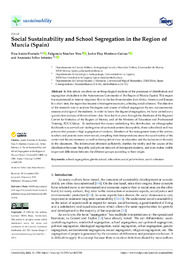Por favor, use este identificador para citar o enlazar este ítem:
https://hdl.handle.net/11000/31229Registro completo de metadatos
| Campo DC | Valor | Lengua/Idioma |
|---|---|---|
| dc.contributor.author | Anton, Fina | - |
| dc.contributor.author | Sánchez Vera, Fulgencio | - |
| dc.contributor.author | Martínez Guirao, Javier Eloy | - |
| dc.contributor.author | Téllez Infantes, Anastasia | - |
| dc.contributor.other | Departamentos de la UMH::Ciencias Sociales y Humanas | es_ES |
| dc.date.accessioned | 2024-02-07T13:37:58Z | - |
| dc.date.available | 2024-02-07T13:37:58Z | - |
| dc.date.created | 2022-01 | - |
| dc.identifier.citation | Sustainability 2022, 14(3) | es_ES |
| dc.identifier.issn | 2071-1050 | - |
| dc.identifier.uri | https://hdl.handle.net/11000/31229 | - |
| dc.description.abstract | In this article we show an anthropological analysis of the processes of distribution and segregation of students in the Autonomous Community of the Region of Murcia (Spain). This region has experienced an intense migratory flow in the last three decades from Africa, America and Europe. In a short time, the region has become a heterogeneous society, affecting social cohesion. The objective of the research was to analyze the degree and causes of school segregation by sex, socioeconomic reasons and origin of the students. In order to know the degree of segregation, we have carried out a quantitative analysis of the enrollment data from last five years through the databases of the Regional Center for Statistics of the Region of Murcia, and of the Ministry of Education and Professional Training, EDUCAbase. To understand the causes underlying this distribution, an ethnographic fieldwork was carried out visiting nine educational centers (four public, three subsidized and two private) that present a high segregation of students. Members of the management team of the centers, teachers and parents were interviewed, compiling their interpretations about the social reality of the center and the environment, as well as their point of view on education and the inclusion of diversity in the classroom. The information obtained sufficiently clarifies the reality and the causes of the distribution between the public and private network of immigrant students, and even makes visible important differences between the different groups according to their origin. | es_ES |
| dc.format | application/pdf | es_ES |
| dc.format.extent | 21 | es_ES |
| dc.language.iso | eng | es_ES |
| dc.publisher | MDPI | es_ES |
| dc.rights | info:eu-repo/semantics/openAccess | es_ES |
| dc.rights | Attribution-NonCommercial-NoDerivatives 4.0 Internacional | * |
| dc.rights.uri | http://creativecommons.org/licenses/by-nc-nd/4.0/ | * |
| dc.subject | school segregation | es_ES |
| dc.subject | ghetto school | es_ES |
| dc.subject | education | es_ES |
| dc.subject | social polarization | es_ES |
| dc.subject | social cohesion | es_ES |
| dc.subject.other | CDU:572 - Antropología | es_ES |
| dc.title | Social Sustainability and School Segregation in the Region of Murcia (Spain) | es_ES |
| dc.type | info:eu-repo/semantics/article | es_ES |
| dc.relation.publisherversion | https://doi.org/10.3390/su14031580 | es_ES |

Ver/Abrir:
sustainability-14-01580 (1).pdf
334,14 kB
Adobe PDF
Compartir:
 La licencia se describe como: Atribución-NonComercial-NoDerivada 4.0 Internacional.
La licencia se describe como: Atribución-NonComercial-NoDerivada 4.0 Internacional.
.png)